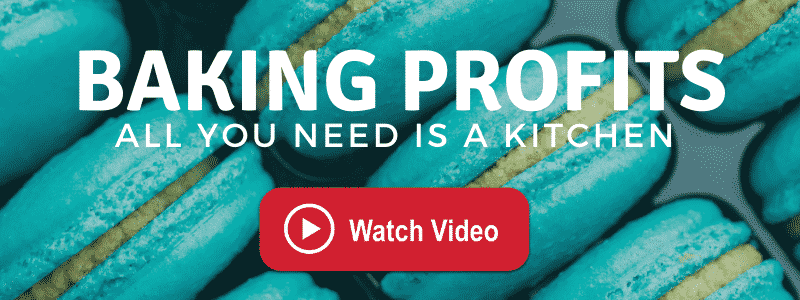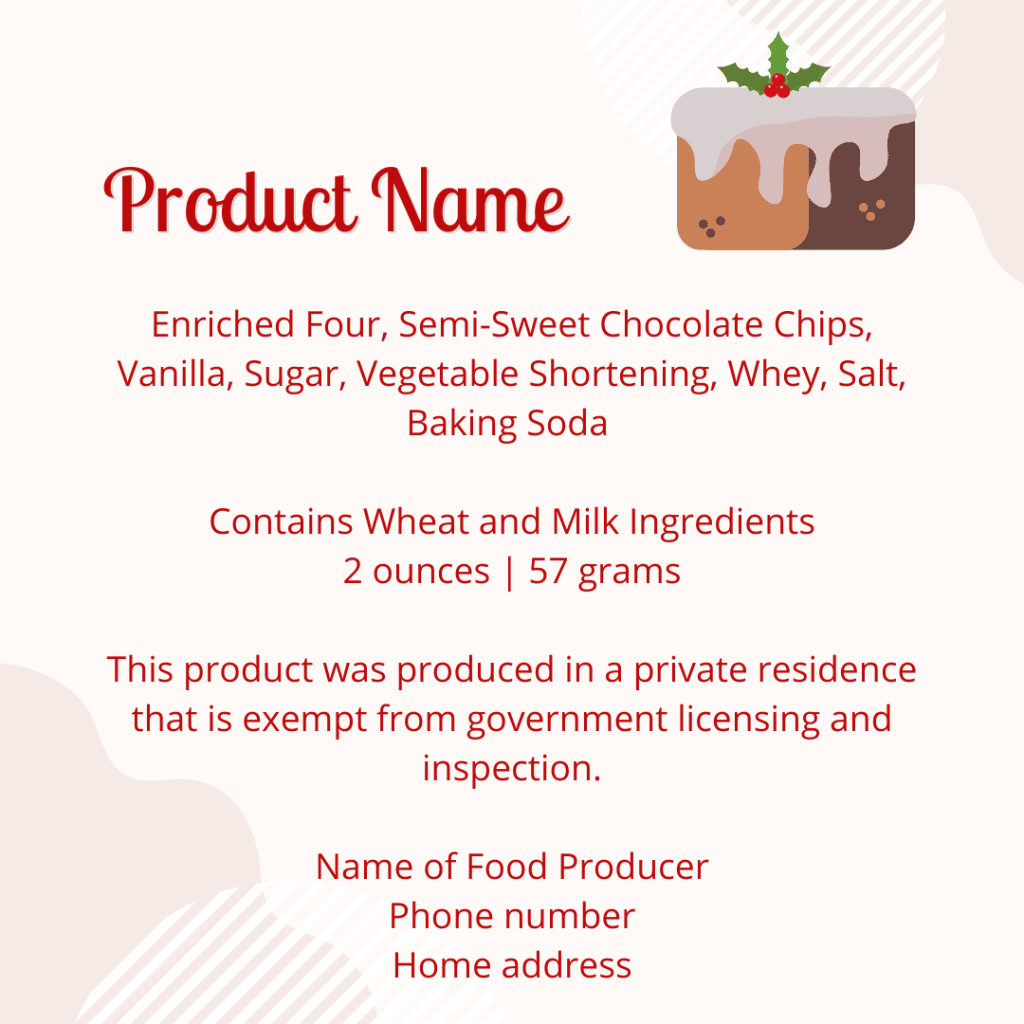Oklahoma cottage food laws make it easy to get started. Oklahoma limits your annual sales to $75,000. But getting started is as simple as saying, “I’m a cottage food entrepreneur!”
Table of Contents
HOW TO START YOUR COTTAGE FOOD BUSINESS IN OKLAHOMA – LICENSING

To start your cottage food business in Oklahoma, simply follow these steps:
STEPS TO START
Always contact your local city / county office and verify if a business license is required prior to starting. Oklahoma requires cottage foods to be produced in your residence.
This is simply done by calling the main number to your city and letting them know you are starting a cottage food business and ask if you need a business license.
- Pick foods to offer from the “allowed” food types listed below.
- Check with your local city/county for any zoning restrictions
- Get your sales tax license
- Get labels made (see label example below)
- Start baking/cooking, marketing and selling
OKLAHOMA COTTAGE FOOD LAWS – Foods That Are Allowed
Oklahoma allows two categories of home produced foods: NTCS (non-time-or-temperature-controlled for safety) and TCS (time-or-temperature-controlled) foods.
Examples of NTCS Foods (not a complete list)
- Breads and sweet breads
- Cookies
- Brownies and fudge
- Donuts
- Muffins
- Scones
- Candies
- Tarts
- Tortillas
- Honey (flavored or blended, or from out-of-state hives; not including raw honey/honeycomb from Oklahoma hives – see Honey Sales Act)
- Trail mix
- Granola
- Further processed nuts and nut butters
- Popcorn
- Dry mixes
- Dry pasta
- Fruit jams and jellies (prepared in compliance with USDA home canning guidelines)
- Cakes with hard icings or frostings
- Fruit pies with fruit and sugar fillings
- Most fermented and pickled foods
- Salsas
- Most processed fruits
- Most fruit juices
- Roasted coffee beans
- Non-alcoholic drinks like plain seltzer
- Soda pop
- Coffee
- Vanilla extract
Examples of TCS Foods (Not a complete list)
To sell TCS food, you need to pass a food safety training course, such as ServSafe Food Handler or Manager Training. You can do it online and shouldn’t take more than 8 hours. Check the list of ServSafe classes or check your county health department information.
- Food requiring refrigeration
- Perishable baked goods
- Low acid canned foods
- Meat, poultry, seafood, meat by-products
- Unpasteurized milk
- Cakes with custard filling
- Custard or meringue pies
- Cheesecake
- Pumpkin, sweet potato and pecan pies
- Sauces
- Butters
- Ice cream
- Cheese
- Cooked pasta
- Cooked eggs
- Some processed fruits
- Processed vegetables
- Cooked beans
- Cooked rice
- Cooked potatoes
- Many flavored tea and coffee-based beverages
- Many smoothie-type beverages
If the food item(s) you wish to make aren’t on this list, you can contact your local Agriculture Extension Office and make sure it is allowed.
Real Life Cottage Food Entrepreneurs and Opportunities
- Cakes – teacher turns kitchen into bakery
- Doughnuts – cottage mini donut vendor
- Fruit jams and jellies – See Additional Requirements Here
- Kettle corn – real kettle corn vendors from home
- Popcorn (plain and flavored) – see a real home vendor here
- Talk and Join hundreds of others here: VendorsUnited.com
OKLAHOMA COTTAGE FOOD LAWS – PROHIBITED FOODS
- Unprocessed fruit
- Unprocessed vegetables
- Unprocessed nuts
- Casseroles, empanadas, fried pies, tamales, etc. that contain meat, poultry, or seafood
- Alcoholic beverages
- Unpasteurized milk products
- Raw eggs
- Hardboiled whole eggs
- Seafood (including freshwater fish and other aquatics)
- Meat (including beef, pork, lamb, wild game, snakes)
- Meat products (including lard, pigskins, jerky)
- Poultry products (including chicken, turkey, wild game birds)
- Cannabis or marijuana products
- Pet foods and treats
NOTE: Although eggs, milk and dairy products are not allowed, they may be allowed as ingredients in other products. Many prohibited foods that are baked or cooked into the allowed foods are rendered harmless (non-TCS) and therefore allowed.
OKLAHOMA ANNUAL SALES LIMITS
Most states set a cap on what you’re allowed to make annually.
This is usually put in place to push you towards opening a full-fledged retail business while at the same time letting you start from home.
Oklahoma sets this limit at $75,000 gross per year. Hardly enough to use to grow and expand and many don’t report accurately in order to save up to expand into a licensed business.
Below is what the state of Colorado puts out to help folks wanting to go beyond cottage foods.
Colorado created a brochure on going beyond cottage food once you’ve outgrown or hit your maximum allowed income.
I have provided it here for a resource as you grow your business and wish to expand.

ACIDITY LEVELS AND TESTING
Most states determine if a food is non-potentially hazardous by the acidity level found in the food. The higher the acidity, the more stable at a range of temps, that food product is.
For example: milk is low acidity and requires temperature controls.
The acidity of foods is measured by pH.
• The range of pH is commonly considered to extend from zero to 14. A pH value of 7 is neutral because pure water has a pH value of exactly 7.
Values less than 7 are considered acidic, while those greater than 7 are considered basic or alkaline.
• All fruits are acidic foods and are usually tart and sour. Ex: tomato, lemon, peach, apple, etc.
• The FDA rule for acidic foods states that a food must have a pH below 4.6 to be sold as a minimally processed food
• The reason for this is bacteria does not grow at this level of acidity.
• The exclusion shall not be construed as allowing the sale of low acid foods (pH > 4.6) i
hermetically sealed containers (i.e. home-canned green beans, peas, etc.) when such
food is not prepared in a permitted establishment.
TESTING
Some states require testing if the pH level is unknown.
For many food products, the pH level is already known. You can test for pH yourself using a pH spear tester. (make sure it is made for food and has a long spear tip).
Oklahoma State University shares an awesome guide for selecting the correct tester for foods and liquids which includes tips and tricks for operation and maintenance. Get The Guide Here.
OKLAHOMA COTTAGE FOOD LAWS LABELING REQUIREMENTS
Labeling (Producer): The items listed in the section below under “Product Label requirements” on the package, on the bulk container (if applicable), on a placard if not packaged (if served like a pie in a diner), or on a webpage if sold online.
Labeling (Reseller): Placard at point of sale or as a consumer advisory on a menu if used as ingredient that states: “This product was produced in a private residence that is exempt from government licensing and inspection.” Information must also be available to the customer in an easily carriable form, such as a card, if the product is not packaged.
The basic information that must be on the label is as follows:
Any “prepared food” sold by a “home food establishment” must have a label affixed, when possible, to the product containing the following information in a 10-point font or larger:
- Name and phone number of the producer (or an OK Food Freedom Act number)
- Physical address where the product was produced (or an OK Food Freedom Act number).
- Description of the product.
- Ingredients in descending order of proportion.
- Weight in standard and metric units (specific to honey).
- A statement indicating the presence of any of the eight most common allergens, including sesame seeds, milk, eggs, peanuts, tree nuts, soy and wheat, sesame, fish and crustacean shellfish.
- Legible print stating, “This product was produced in a private residence that is exempt from government licensing and inspection.”
COTTAGE FOOD LABEL EXAMPLE
Below is an example of what Oklahoma homemade food labels might look like.

Using VistaPrint.com or similar – you can quickly create professional labels that not only serve to meet the state cottage food guidelines but also serve for marketing your awesome business and products.
You’ll find some fantastic examples of this from members inside VendorsUnited.com
ALLERGENS ON LABELING
The FDA lists nine (9) major food allergens. Listing any of these on your label is a smart business practice and will certainly help your customers choose a product.
- Milk
- Eggs
- Fish (e.g., bass, flounder, cod)
- Crustacean shellfish (e.g., crab, lobster, shrimp)
- Tree nuts (e.g., almonds, walnuts, pecans)
- Peanuts
- Wheat
- Soybeans
- Sesame seeds
Simply add to your label: “CONTAINS: SOYBEANS” Some go as far to announce that a certain allergen is used in the same kitchen.
Some states require you list any potential allergens and potential for any cross contamination even if the allergen is not used in the recipe.
FDA Allergen Labeling Example: Contains Wheat, Milk, Egg, and Soy
WHERE CAN I SELL MY COTTAGE FOOD PRODUCTS
Oklahoma Cottage Food Laws – Sales Rules
Non time or temperature controlled for safety homemade food products can be sold without a food safety certification at:
- Farmers markets;
- According to the Oklahoma State Department of Health, a “farmers market is defined as a designated area in which farmers, growers or producers from a defined region gather on a regularly scheduled basis to sell at retail non-potentially hazardous farm food products and whole shell eggs to the public.
Some, not all, farmers markets require that a portion of the raw food ingredients used by the individual vendor to produce a product must have been grown or raised by the vendor.
- According to the Oklahoma State Department of Health, a “farmers market is defined as a designated area in which farmers, growers or producers from a defined region gather on a regularly scheduled basis to sell at retail non-potentially hazardous farm food products and whole shell eggs to the public.
- On site, meaning your “primary residence.”
- Internet, telephone sales
- Retail stores (NOT restaurants or via catering)
- Craft or flea markets
- Cooperatives (such as the Oklahoma Food Cooperative).
- Membership-based buying clubs (for example a local “Dessert of the Month Club”).
Inside kitchenincome.com you can find out how cottage food entrepreneurs are getting sales faster than they can make the food.
FOOD HANDLER TRAINING AND BEST PRACTICES
Oklahoma requires you take a food safety course if you are selling time- or temperature-controlled-for-safety homemade food products. The training is available online and should take less than 8 hours. Check the Oklahoma restaurant and food safety website for approved trainings.
For time or temperature controlled foods, you must sell and deliver directly to the customer. These foods may not be sold or delivered by a third party.
Knowing the safe handling practices will protect you and your customers, it is always a good idea to take a quick online class and get certified, even if it is not required.
There are many short courses you can take online and actually get certified and be able to share that with your customers.
Many of our VendorsUnited.com members are proud to display their food safety certificates as a way to insure their customers that they care. This helps your business.
- Short courses that provide food handling and safety certification
- Free info from the FDA – food safety
SAFE PRACTICES
Much of this may seem like common sense, but even if you already know, it’s a good idea to remind yourself with a list of things that can prevent you from missing something small.
And if for no other reason… CYA! CYA = Cover Your A#%
CLEAN WORK AREA / WORK SPACE / SANITIZATION
Providing safe to eat foods from your kitchen – starts in your kitchen.
Keep your area clean and sanitized to avoid cross contamination and to insure you provide your customers and clients with the safest and best foods they can get.
The following are some “common” sense things you can do to insure the best environment for preparing foods to sell:
- Keep all equipment and surface areas clean and sanitized
- Make sure window and door screens are bug proof with no gaps
- Keep ingredients separate to prevent cross contamination / e.g. raw eggs near flour
- No pets in work area and preferably none in the home
- Allow no-one with a cold, sniffles or sick in kitchen while preparing foods
- Wipe down walls and clean floors daily
- Use good lighting to avoid missing unclean areas
- Keep window and door screens in good repair to keep insects out
- Wash hands frequently while working and use food grade gloves for extra safety
- Keep areas of food storage and equipment storage clean and sanitized
RECORD KEEPING
Why keep these types of records? Let’s say the inspector calls you and says they got a report that your banana bread, someone purchased, made them sick.
You’ll be able to show that you didn’t even make banana bread that week and that the person who reported you, bought that 4 weeks ago and you weren’t even the one that sold it to him.
This does not need to be complicated. I love my yellow legal pads and they make an inexpensive tool for keeping up with the following:
- The recipes you use including ingredients
- The process you use to prepare that specific recipe: (can be just like recipe instructions)
- Date made (can be coded for your own use only if your state doesn’t require the production date) e.g. Made 12.22.29 = 292212
- Date sold (you can have a batch code to help track a certain batch) Simply write down date you sold an item
- Location sold is another great piece of information to keep track of
- Sales receipts are something great to keep for a couple of reasons and over at KitchenIncome.com I dive into the best practices, best systems and best methods for tracking, managing, selling and shipping.
COTTAGE FOOD lIABILITY INSURANCE
We live in a society that likes to sue. I can sue you for wearing that color shirt. No kidding!
Of course I probably won’t win, but at the very least, it’s gonna cause you stress and some costs.
Liability insurance is a MUST.
It can be expensive – but several years ago, I found FLIP and by far, they gave me the most protection (coverage) and allow you to run your cottage food business without fear of being sued.
WHY? Because they provide the lawyers. And their lawyers… they are good!
Of course you should price shop around with your local agent or a national brand company, but rest assured, I’ve done all the legwork for you.
Alternatively, some folks opt to get bonded. You’ve heard the saying before: “licensed and bonded”.
A bond is usually provided from an insurance bonding company or your own insurance company. My first time, I got a bond at State Farm.
A bond is expensive comparatively but is less out of pocket in the beginning. Of course, it’s way, way less insurance / coverage too.
A $10,000 bond may cost $50 annually while a $2,000,000.00 liability policy may cost a few hundred a year.
No matter what you decide… knowing you’re insured against frivolous lawsuits is worth every penny.
OKLAHOMA COTTAGE FOOD LAWS IMPORTANT LINKS
- Oklahoma State University – Cottage Food Facts
- Farm to Market Guide and Regulations
- Facebook Group In Oklahoma for Cottage Food Owners
- Sales Tax License
- Oklahoma Food Safety Website
- Read the Oklahoma Homemade Food Freedom Act (updated 2021)
OKLAHOMA COTTAGE FOOD CONTACT INFO
Oklahoma State University
139 Agricultural Hall
Stillwater, OK 74078
(405) 744-5398
(614) 728-6250
Oklahoma Department of Agriculture Food and Forestry (405) 521-3864
MAP AND CONTACTS FOR YOUR COUNTY AG EXTENSION
UPDATES TO OKLAHOMA COTTAGE FOOD LAWS
From time to time, links, info, rules and numbers change, are updated or made obsolete.
Although I spend time daily with hundreds of vendors (many of which are cottage food businesses) – I can miss an update.
If you find a broken link or outdated state information… please let me know and I’ll send you a special thank you for helping me maintain the best site on the internet for the cottage food industry.
My goal has always been to have a central place that is absolutely free for those starting out or existing entrepreneurs who use their homes and kitchens to make real incomes.
Please send to [email protected] / or post inside the private VendorsUnited.com group.
Need more resources? Check it out HERE (Helpful Resources)
Take a peek at the best vendors on the planet, the community that rocks the food vending world: Vendors United…

Disclaimer
This information is provided to help those interested in starting a cottage food business. It is not a document made by the state government. This information is not provided as law nor should be construed as law. Always use the contact information for each state to confirm compliance and any changes.
Did we help you? Help us to share this information…
 WATCH VIDEO!
WATCH VIDEO! WATCH VIDEO!
WATCH VIDEO!
You’re information is wrong
Ben, Oklahoma has set the annual sales limit on the Cottage Food Law at $20,000. Your site above states the limit is $75,000.
Hi Judy,
Thanks for your comment! The limit has changed recently under Oklahoma’s Homemade Food Freedom Act: As of November 1, 2021, the allowable earnings for a home food business is $75,000 each year in sales. 🙂
I couldn’t find a regulation prohibiting selling and sending baked goods out of state. I do see that there is a regulation that prohibits craft fairs…etc
Please advise
Thank you.
I always go with the ask for forgiveness instead of beg for permission. 🙂